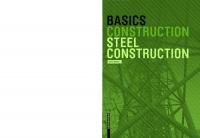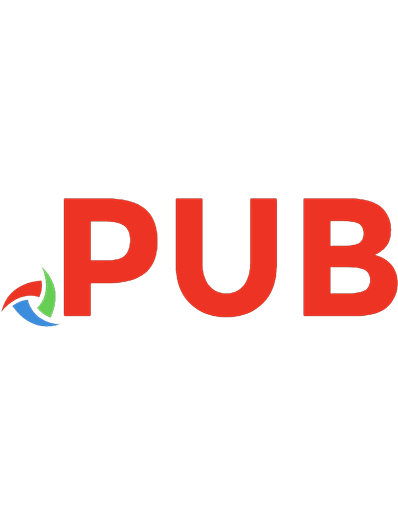P213: Joints in Steel Construction Composite Connections
194 114 3MB
English Pages 104 Year 1998
Table of contents :
FOREWORD
ACKNOWLEDGEMENTS
CONTENTS
FUNDAMENTALS
Mechanics of composite connections
Detailing
Materials
Frame Design
1 INTRODUCTION
1.1 About this design guide
Figure 1.1
1.2 Scope
1.3 Benefits
1.4 Frame Layout
1.4.1 Unpropped construction
Beam Design Criteria
Choice of connections
Typical framing solutions
Figure 1.2 Typical floor beam layout
Figure 1.3 Alternative floor beam layout
1.4.2 Propped construction
1.5 Frame design Methods
Global analysis - ULS
1.6 Connection characteristics
Global analysis - SLS
Figure 1.4 Rotation of a composite connection
Figure 1.5 Classification of connections
1.7 Exchange of information
1.8 Major symbols
2 CONNECTION DESIGN
2.1 Design Philosophy
Figure 2.1 Typical composite connection at internal column, showing force transfer by the various elements
2.2 Tension components
2.2.1 Tensile force in the reinforcement
2.2.2 Tensile force in the bolts
2.2.3 Longitudinal shear force
Figure 2.2 Transfer of longitudinal shear forces in a composite beam
2.3 Compression components
2.3.1 Beam lower flange and web
2.3.2 Column web
2.4 Column web panel
Figure 2.3
2.5 Vertical shear components
2.6 Structural integrity
3 FRAME DESIGN
3.1 Introduction
3.2 Ultimate limit state
3.2.1 Beams
Figure 3.1 Applied moments and moment capacities for beams with different support connections
Table 3.1 Combined beam and connection moment capacity ranges
Figure 3.2 Detailed design procedure for a beam with composite connections in a semi-continuous braced frame
Lateral buckling adjacent to supports
3.2.2 Columns
3.3 Serviceability limit state
4 'STEP BY STEP' PROCEDURES
4.1 Introduction
4.2 Beam-to-column connections
Figure 4.1 Check zones for a composite end plate beam-to-column connection
Figure 4.2 Flow diagram - connection design checks
Calculation of moment capacity - construction stage
Figure 4.3 Moment resisting bare steel connection
Step 1 Potential resistances of reinforcement and bolt rows in the tension zone
Reinforcement
Bolts
Figure 4.4 Potential resistance of reinforcement and bolt rows
Step 1a Reinforcement Yielding
Potential resistance
Minimum area of reinforcement
Figure 4.5 Elongation limits for reinforcement
Table 4.1 Minimum area of reinforcement - 'compact' and 'plastic' connections
Maximum area of reinforcement
Figure 4.6 Truss model for connection behaviour under unbalanced moment
Table 4.2a Maximum areas of reinforcement that can be adopted without column compression stiffening, S275 columns
Table 4.2b Maximum areas of reinforcement that can be adopted without column compression stiffening, S355 columns
Step 1b End plate or column flange bending and/or bolt yielding
Mode 1 Complete flange or end plate yielding
Mode 2 Bolt failure with flange/end plate yielding
Mode 3 Bolt failure
Table 4.3 Tensile capacity of a single 8.8 bolt
Figure 4.7 Influence of stiffeners
Backing plates
Stiffeners
Table 4.4 Leff for equivalent T-stubs for bolt row acting alone
Table 4.5 Leff to be considered for a bolt row acting alone (expressions to be used from Table 4.4)
Table 4.6 Leff to be considered for bolt rows acting in combination (expressions to be used from Table 4.4)
Figure 4.8 Connection geometry
Figure 4.9 Values for bolt rows adjacent to a stiffener or beam flange
Step 1c Web tension in beam or column
General
Stiffeners
Figure 4.10 Typical web tension checks
Step 1d Modification of bolt row resistances
Figure 4.11
Step 1 Worksheet: tension zone
Step 2a Compression check - column
Column web crushing (bearing)
Figure 4.12 Force dispersion for web crushing
Column web buckling
Figure 4.13 Length for web buckling
Step 2b Compression check - beam
Beam flange crushing (bearing)
Figure 4.14 Compression in beam flange only
Figure 4.15 Compression in beam flange and portion of web
Step 3 Design for column panel shear
Figure 4.16 Web panel subject to shear force
Step 4 Calculation of moment capacity
Force distribution
Figure 4.17 Translation of potential resistances into allowable forces
Moment capacity
Moment capacity modified by axial load
Step 5 Design for vertical shear forces
Major axis connections
Figure 4.18 Tension and shear bolts
Table 4.7 Shear capacities of single 8.8 bolts
Minor axis connections
Figure 4.19 Shear in minor axis beam-to-beam connection
Table 4.8 Capacities for ordinary bolts to BS 3692 anda BS 4190
Step 6a Design of column compression stiffeners
Figure 4.20 Stiffener bearing and buckling
Effective outstand of compression stiffeners
Stiffener/column web crushing and buckling
Weld design
Welds to flanges
Welds to webs
Step 6b Design using column flange backing plates
Mode 1 Complete flange yielding
Mode 2 Bolt failure with flange yielding
Mode 3 Bolt failure
Figure 4.21 Column flange backing plates
Step 6c Design of tension stiffeners
General
Stiffener net area
Web tension
Figure 4.22 Tension stiffeners
Figure 4.23 Effective web lengths
Flange bending
Figure 4.24 Geometry for force distribution to stiffeners
Weld design
Step 6d Design of supplementary web plates
General
Column web tension
Column web crushing and buckling
Column panel shear
Figure 4.25 Dimensions and welds
Step 7 Design of welds
Tension flange welds
Figure 4.26 Forces in welds
Compression flange welds
Figure 4.27 A partial penetration butt weld with superimposed fillets
Web welds
Figure 4.28 Force distribution in welds
4.3 Beam-to-beam connections
Figure 4.29
Step 1a Reinforcement yielding
Potential resistance
Minimum area of reinforcement
Maximum area of reinforcement
Step 2b Compression check - supported beam
Beam flange crushing (bearing)
Figure 4.30
Figure 4.31 Compression in beam flange and portion of web
Step 4 Calculation of moment capacity
Force distribution
Moment capacity
Moment capacity modified by axial load
Figure 4.32 Translation of potential resistances into allowable forces
5 CONNECTION DETAILING
5.1 Beam-to-column connections
Reinforcement and shear connection
Steelwork
Figure 5.1 Geometrical detailing rules - beam-to-column connections
5.2 Beam-to-beam connections
Reinforcement and shear connection
Figure 5.2 Geometrical detailing rules - beam-to-beam connections
Steelwork detailing
REFERENCES
APPENDICES
Appendix A Worked example
1 Connection details
2 Tension zone
2.1 Rebar
2.2 Bolt row 1 (only row in tension)
3 Compression zone
3.1 Column web crushing
3.2 Column web buckling
3.3 Beam flange crushing
4 Column panel shear zone
5 Calculation of moment capacity
5.1 Equilibrium
5.2 Column compression stiffness
5.3 Moment capacity
6 Calculation of vertical shear capacity
Appendix B Design tables for standard composite 'plastic' connections
B.1 Introduction
B.1.1 Beam side
Moment capacity
Dimension A
Weld sizes
B.1.2 Column side
Tension zone
Compression zone
Panel shear zone
B.1.3 Worked example using the capacity tables
Worked example using the capacity tables
B.2 Capacity tables
1 Row M20 8.8 Bolts 200x12 S275 End Plate Beam Side
1 Row M20 8.8 Bolts 200x12 S275 End Plate Column Side
2 Rows M20 8.8 Bolts 200x12 S275 End Plate Beam Side
2 Rows M20 8.8 Bolts 200x12 S275 End Plate Column Side
2 Rows M20 8.8 Bolts 250x12 S275 End Plate Beam Side
2 Rows M20 8.8 Bolts 250x12 S275 End Plate Column Side
1 Row M24 8.8 Bolts 200x15 S275 End Plate Beam Side
1 Row M24 8.8 Bolts 200x12 S275 End Plate Column Side
2 Rows M24 8.8 Bolts 200x15 S275 End Plate Beam Side
2 Rows M24 8.8 Bolts 200x15 S275 End Plate Column Side
2 Rows M24 8.8 Bolts 250x15 S275 End Plate Beam Side
2 Rows M24 8.8 Bolts 250x15 S275 End Plate Column Side
B.3 Detailing tables




![RF-/Joints Manual Design of Connections in Steel and Timber Structures [2014 ed.]](https://dokumen.pub/img/200x200/rf-joints-manual-design-of-connections-in-steel-and-timber-structures-2014nbsped.jpg)





